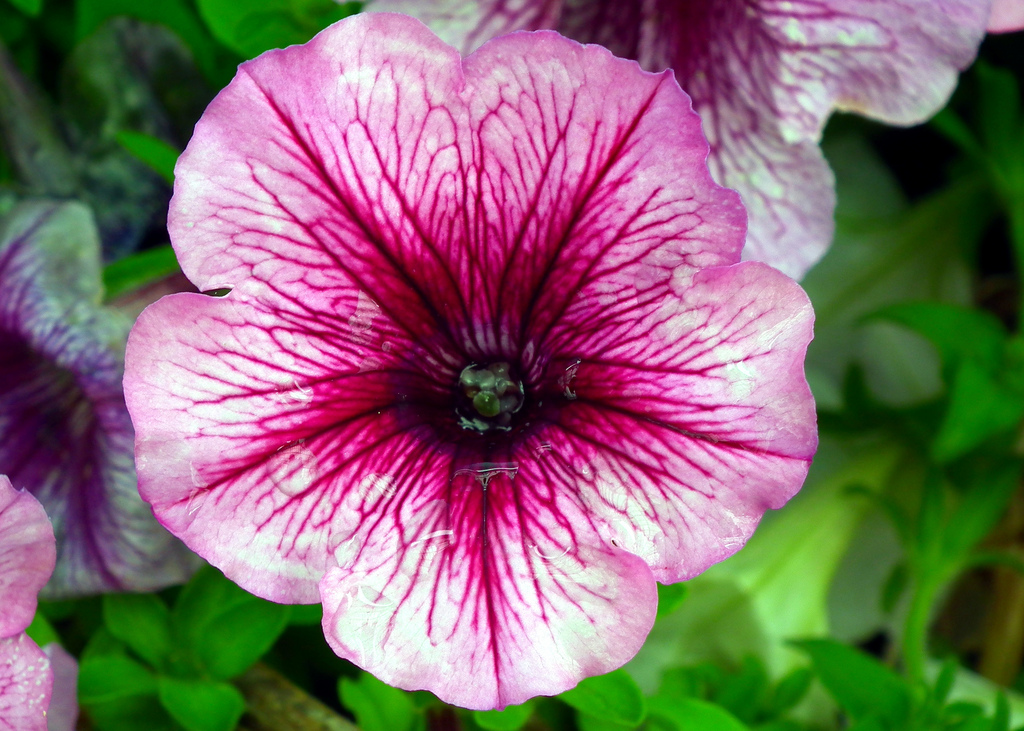 Plant Biology
Plant Biology
Attractive in the dark — how petunias may help to feed humanity

Many plants, including staple crops, need insects to reproduce. Changing climate and human interference threaten the sensitive relationships between plants and their pollinators. Many aspects of these relationships are not well understood. However, this knowledge may be crucial to sustain and increase crop production to feed an ever-growing human population.
Petunias are very popular garden and container plants around the globe. They are of South American origin, and were first described in 1803 from flowers collected in Uruguay. Favoured by gardeners for their diverse range of shapes and colours, petunias have also found their way into science: researchers use them to study flower pollination.
The flowers of common garden petunia release substances, known as floral volatiles, to attract nocturnal pollinators, such as the hawkmoth. The plant depends on these insects for its reproduction. Release of the attractants must be timed so that the moths can find the flowers at night; but, they should not be produced wastefully during the day. All this is regulated by the plant's internal, or circadian, clock. Many living beings, including humans, possess such a circadian clock. It tells us, for example, when to be tired, and is responsible for the infamous jet-lag. However, the precise mechanisms underlying the regulation of attractant release from petunia flowers have remained largely unknown, until recently.
Researchers at the University of Washington in Seattle were keen to shed light on this regulation. They monitored production of different components related to the release of floral volatiles. They observed that even when the plants were kept in constant darkness the attractants were still released in regular 24-hour intervals - indicating control by the circadian clock.
In order to learn more about the processes behind that control, the researchers benefitted from another plant that is commonly used for scientific studies: the thale cress, Arabidopsis thaliana.
The way the circadian clock of this plant works is well studied. An important part of the system is a protein that can switch certain mechanisms on or off depending on the circumstances. It is called LHY (for Late Elongated Hypocotyl). The researchers suspected that a similar factor was responsible for the regulation of timely attractant release in petunias. They found a close match, which they called PhLHY (for Petunia hybrida, the Latin name of the common garden petunia). They discovered that PhLHY is mainly produced in the morning (a characteristic shared with its cousin from Arabidopsis). They also showed that excess PhLHY has the same effect on the plant as its distant cousin; namely, developmental problems, delayed flowering, and elongated stems (called hypocotyl in seedlings; hence the name of the protein). In short, both proteins appear to have the same biological role.
The way PhLHY functions is intriguing: in its presence, the production of pollinator attractants is suppressed; however, since it is mainly produced in the morning, the suppressive effect wears off over the day. In the night, when almost all PhLHY is gone, the production and release of attractants are at a maximum - just in time for the hawkmoths!
The identification of PhLHY provides the first mechanistic link between the circadian clock and emission of floral pollinator attractants. It may be an important step towards a better understanding of the processes that regulate plant-insect relationships.
The scientists performing this work suggest that with this knowledge production of floral volatiles could be increased in certain crops to attract more pollinators. Even more interestingly, the timing of their release could be regulated so as to attract particular insects. In this way, crops could be engineered to capitalise on pollinators that predominate in a given region. This may open up new possibilities for farmers to cultivate areas that currently produce poor yields.
Original Article:
Fenske, M., Hewett Hazelton, K., Hempton, A., Shim, J., Yamamoto, B., Riffell, J. and Imaizumi, T. (2015). Circadian clock gene LATE ELONGATED HYPOCOTYL directly regulates the timing of floral scent emission in Petunia. Proceedings of the National Academy of Sciences, 112(31), pp.9775-9780.Next read: Capturing Mother Nature at work: seeing how plants make vitamin B6 by Graham Robinson , Teresa Fitzpatrick
Edited by:
Dr. Tobias Preuten , Editorial Advisor - Review operation manager
We thought you might like
Lab-life: the afternoon siesta of the fruit fly
Jul 13, 2016 in Evolution & Behaviour | 3.5 min read by Edward GreenA Weekend Camping is Just What the Doctor Ordered
Jun 21, 2017 in Health & Physiology | 4 min read by Hannah Kent Ritchie , Ellen R. Stothard , Kenneth P. WrightStop all the clocks: the hidden long-term consequences of sleep loss
Sep 22, 2020 in Neurobiology | 4 min read by Charlotte N. Hor , Paul FrankenOut of the darkness: how plants prepare for, and endure, life in the sun
Nov 28, 2016 in Plant Biology | 3 min read by Graham RobinsonMore from Plant Biology
Unravelling the Secrets of Pine Roots: A Tale of Nutrition and Adaptation
Oct 20, 2023 in Plant Biology | 3.5 min read by Rafael Cañas , Francisco OrtigosaStressful memories help plants resist caterpillars
Oct 2, 2023 in Plant Biology | 3.5 min read by Samuel Wilkinson , Adam Hannan Parker , Jurriaan TonDecoding the genome of a jackfruit that grows all year round
Sep 6, 2023 in Plant Biology | 3.5 min read by Tofazzal IslamLife after logging: the tale of recovering tropical forests
Aug 21, 2023 in Plant Biology | 3.5 min read by Maria Mills , Terhi RiuttaEditor's picks
Trending now
Popular topics


